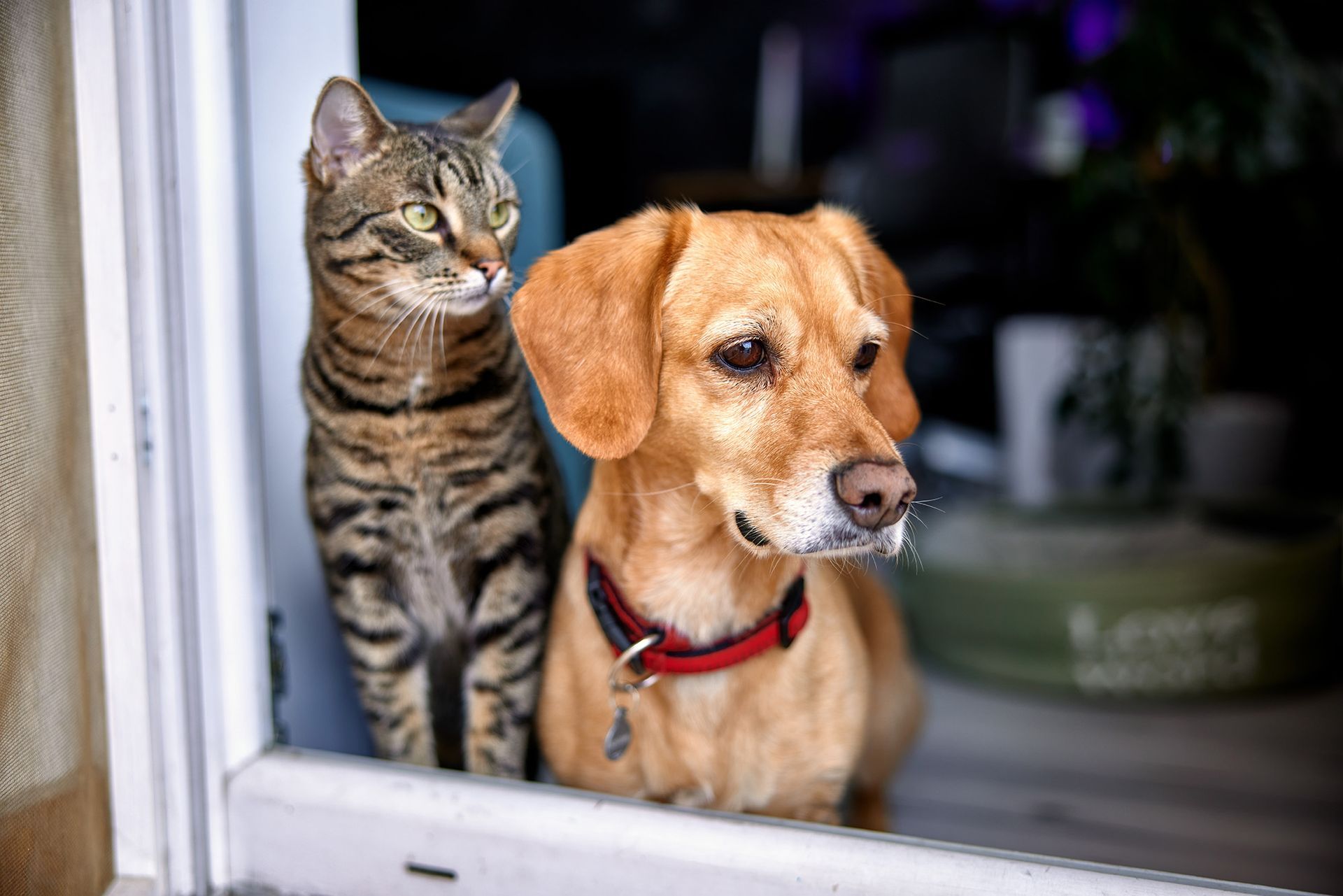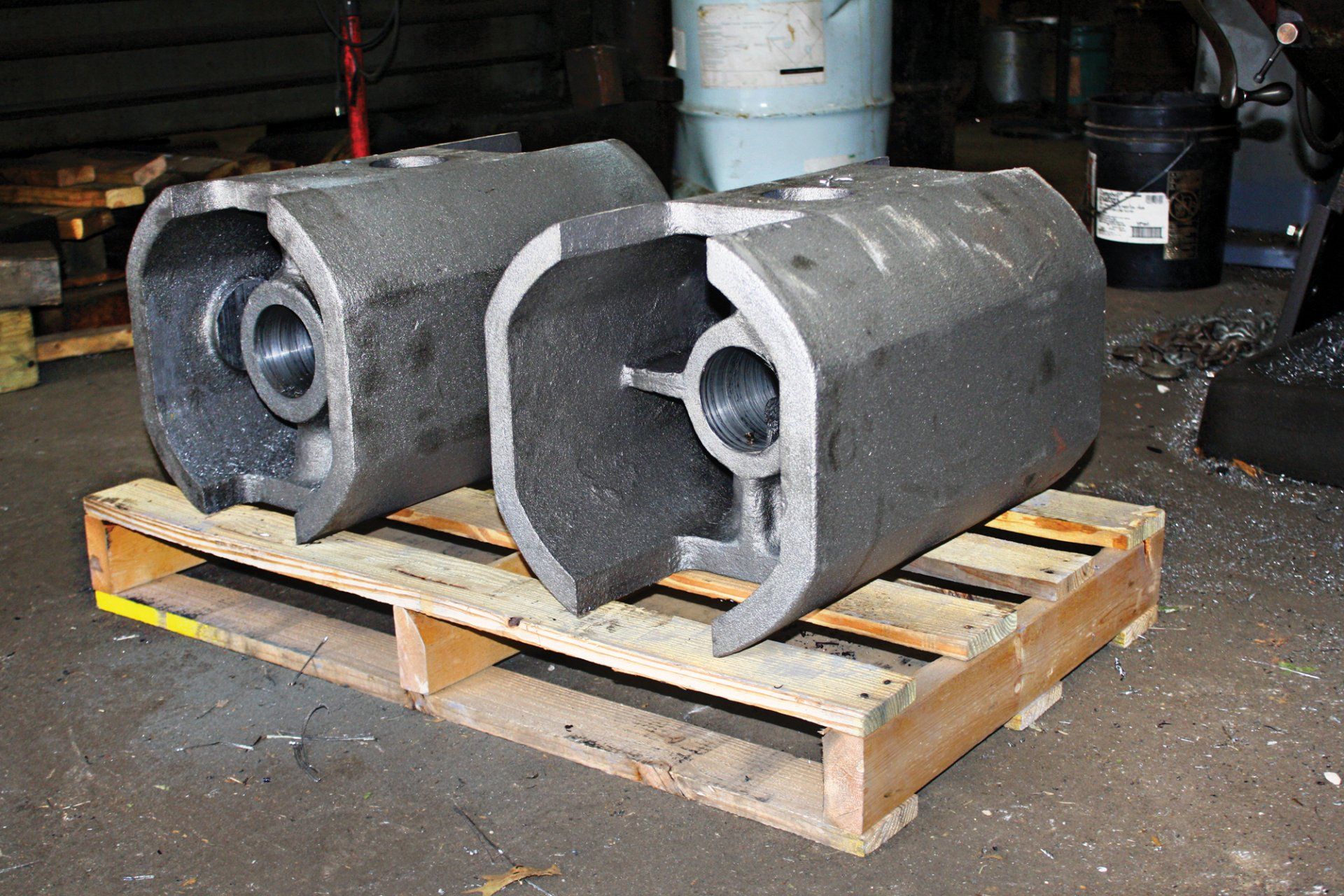Joe Johnson shows the difference between a standard-sized cutter and a custom cutter he had made to complete the ram for the Lake Taneycomo dam project.
Past and present are coming together in the way of a local project with historical significance.
Aurora Motor and Machine, one of the oldest family-owned businesses, and the oldest continuously-owned family business in Aurora began work on a project this past spring to replace important components that regulate the water flow in the historic Lake Taneycomo hydro-electric dam – the oldest hydro-electric dam in Missouri.
Two of the four rams made by Monett Metals, Inc., await final machining by Aurora Motor and Machine before they can be re-installed.
At first look, it seemed like a typical job for a business that takes on all sorts of machining work and a staff that can fix or make just about anything from small engine repairs to ornate rod iron gates.
But digging a little deeper, it became clear that working with parts made more than 100 years ago would present some new challenges.
The parts that need replaced were first installed in the dam in 1913. The wear and tear of more than 100 years of use meant the team at Aurora Motor and Machine couldn’t simply repair the large metal rams, and would need to have new components made.
In the past, the business had worked with Monett’s Mike Renfrow of Monett Metals, Inc., so it was an easy call to reach out to have new rams created from scratch in Monett.
But again, with 100 years between the original pieces being manufactured until now, simply recreating the originals wasn’t an option.
“There are now drawings for this,” Renfrow said. “Typically, we are supplied with a cast and a model for a job, but we were essentially tasked with reverse engineering a worn-out part that needs precise dimensions to work right. We have an engineer that's working to bridge 1913 technology to today.”
Using high-tech computer programs, Monett Metals, Inc., was able to generate a model of the replacement ram and map the flow of molten metal that would be poured into a cast to see exactly how the metal will cool and how strong the resulting part would become.
Monett Metals is a small job shop with approximately 75 employees that can create anything from car parts to industrial augers. But to say Aurora Motor and Machine’s project was just another run-of-the-mill assignment would be an understatement.
As engineers worked out how to recreate the ram, they marveled at how engineers from days past were able to complete the same work without the aid of computers or even calculators.
Using high-tech science, Monett Metals got the work done, and by summer, the first of four rams was shipped to Aurora, where the new-school technologies used to create the ram would encounter old-school experience that would refine the hunk of metal into a working part of the hydro-electric dam.
Joe Johnson of Aurora Motor and Machine took the project on, having some experience working at the dam in his early years. It was clear when he got his hands on the ram and compared it to the original part, the he’d need more than standard shop tools to finish the job.
“There’s nothing on this thing that is standard,” Joe said about the measurements for bore holes and rack teeth that would fit into gears.
“We had to have cutters ground down to the right size to make that rack,” Joe said. “To get the bore size right, we bought a four-inch reamer and it turned out that wasn’t standard. It was 55 thousandths of an inch under four inches.”
Renfrow speculated that the original piece was bored out with an old, worn reamer in 1913. Joe agreed, with the caveat that with more than 100 years gone by, they’d never know for sure why the measurements were what they were.
What he does know, however, is that he has to match the original rams exactly. And that means precision.
While the team at Monett Metal Works showed impressive skill with 3-D renderings of the ram they cast, watching Joe rattle off the math he worked out to machine the ram down to the exact dimensions of the original part was a different kind of skill.
“It’s artisan work,” Renfrow said. “You have a lot of machine operators out there, but you don’t have a lot of machinists like this. They can do almost anything, and if you look around the shop here, you can see something new every time you’re here.”
Once Joe finished work on the first ram, it was taken to the dam and installed. When it worked, Renfrow and Monett Metals went to work casting the next three parts, which were delivered to Aurora in late September. With the needed tools already made or purchased, Joe said he’ll make short work of machining the next three units, and he expects it’ll be another 100-plus years before they have to be replaced again. “Hopefully it won’t be me next time,” he said.
Aurora Motor and Machine has been around almost as long as the Lake Taneycomo dam, opening in 1919 by Omer Hukill. Bud Hukill took over in the 1960s, and continues to run the operation today.
His daughter, Catherine Hukill operates the office side of the operation, and said jobs like the Taneycomo project are their specialty.
“You just can’t find this anymore,” she said. “There’s always something different, you never know what’s going to come through the door. “One day we’re putting a flat bed on a truck, then we’re making racks for Alpine Lumber. If somebody comes to us with something that breaks all the time, we’re going to fix it so it’s going to last. We want it done right. We don’t want to have to see you again,” she said with a smile.
The VFW’s motto is “To honor the dead by helping the living,” and, in short, Buddy Poppies are one way to do just that.
Concerned that World War I veterans who had made the ultimate sacrifice were being forgotten too soon, Madame E. Guerin, of France, took inspiration from Colonel John McCrae's poem, "In Flanders Fields,” which spoke of poppies growing in an Allied graveyard "between the crosses, row on row," and began a push to have veterans’ organization sport red silk poppies in memory of World War I veterans.
The Buddy Poppy idea caught on in the U.S. in May 1922, when the VFW conducted the first nationwide distribution of poppies in the United States.
Later that year, at its National Encampment in Seattle in August 1922, the VFW adopted the poppy as its official memorial flower.
However, Guerin’s American and French Children's League, which supplied the poppies, had been dissolved shortly before the VFW's 1922 poppy sale, making the silk flowers hard to come by for the upcoming 1923 sale.
From adversity blooms inspiration, and the VFW formed an elegant solution that would simultaneously keep the flowers circulating as a reminder of the sacrifices so many veterans made in the name of freedom, and help living veterans who were in need, a tradition that continues to this day.
During its1923 encampment, the VFW decided that its Buddy Poppies would be assembled by disabled veterans and veterans in need, who would, in turn, be paid for their work to provide them with financial assistance. The next year, disabled veterans at the Buddy Poppy factory in Pittsburgh, Penn., assembled VFW Buddy Poppies. The designation "Buddy Poppy" was adopted at that time.
In February 1924, the VFW registered the name Buddy Poppy with the U.S. Patent Office that allows it to guarantee that all poppies bearing that name and the VFW label are genuine products of the work of disabled and needy veterans. No other organization, firm, or individual can legally use the name Buddy Poppy.
Today, Buddy Poppies are still assembled by disabled and needy veterans in VA Hospitals.
VFW posts throughout the country order Buddy Poppies from the national VFW organization, then distribute them throughout their individual communities leading up to Memorial Day in exchange for donations. Those donations are used by individual VFW posts to take care of local veterans in need.
With that business model, the VFW is able to raise money for various veteran programs on a local and a national level.
The Buddy Poppy program provides compensation to the veterans who assemble the poppies, provides financial assistance in maintaining state and national veterans' rehabilitation and service programs, partially supports the VFW National Home for Children and allows the local posts to support veterans at the local level.
Over the years, Tom Wolfe VFW Post 4207 has continued the tradition, selecting “Poppy Girls” to represent the post and its poppy sales for many years.
VFW Post No. 4207 Auxiliary Buddy Poppy Coordinator Linda Adams and VFW Post No. 4207 Quartermaster Randall Adams said the local post celebrated Memorial Day and the Buddy Poppy distribution by selecting a Poppy Girl each May for decades. That tradition ended several years ago, when the local auxiliary disbanded.
However, the auxiliary has been reformed and the post and auxiliary are hoping to bring the tradition back.
But that’s not all that’s changed. Linda said the post traditionally collected donations and distributed poppies at the intersection of U.S. 60 and Highway 37 until a few years ago, when safety concerns changed the location.
Since then, with the exception of last year due to the COVID-19 pandemic, the post has distributed at Walmart.
As long as COVID-19 restrictions allow, Randall said the plan this year is to distribute poppies at Walmart, Price Cutter and Lowe's.
Randall said the post hopes to raise about $1,000 each year through poppy donations to support local veterans.
While the use of poppy funds are strictly regulated, Randall said the Monett Post typically has a single use for the money – to support local veterans in need.
“We use it to help the people who need it,” Randall said. “The vets come to us and tell us what they need, and we try to help them out however we can.”
He added that veterans who are in need do not need to be members of the VFW to seek help. He said the organization is there to help any veteran in need, any way it can.






